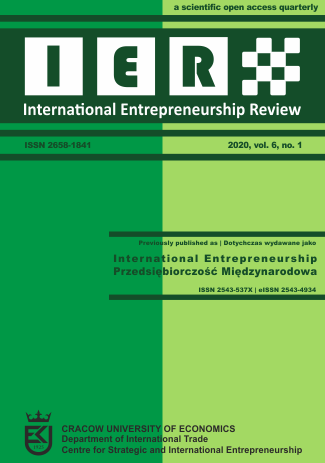Changing role of middle income economies in contemporary international trade: comparative analysis

Abstract
Objective: The purpose of this paper is to analyze selected international trade indicators, and then to verify, if assumption of growing importance of middle income economies (according to the World Bank classification) can be justified.
Research Design & Methods: Article consists of two main parts. In the former some shifts in international merchandise trade in 1995-2018 have been analyzed. In the latter the assessment of selected trade indicators has been included, with particular regard to those, which could be utilized as a basis for verification of growing importance of middle income countries in international trade.
Findings: Between 1995 and 2018 there was a noticeable improvement of middle income countries’ share in global merchandise trade, and their competitive advantage improved dramatically. As confirmed by RCA index analysis, middle income economies improved significantly in all manufactures, and was particularly high in labour-intensive and resource-intensive manufactures, as well as in low-skill and technology-intensive manufactures.
Contribution & Value Added: Analyses concerning economy groupings are still relatively rare, especially in Polish economic literature. Therefore the presented research can be perceived as a quite fresh approach in this field. Finally, usage of wide collection of trade indicators for verification of middle income economies’ international significance should also be treated as a strength of presented paper.
Keywords
developing countries, middle income economies, international trade, trade structure, trade indicators
Author Biography
Marcin Gryczka
Master of Science in Sea Engineering (Szczecin University of Technology, Poland); PhD in Economics – specialization: Foreign Trade (University of Szczecin, Poland). His research interests include foreign trade and international economics, technology transfer and knowledge diffusion in digital era, e-commerce, middle income countries’ role in global economy, Industry 4.0.
References
- Bruckner, M. (2012). Climate change vulnerability and the identification of least developed coun-tries [CDP Background Paper]. United Nations, Department of Economics and Social Affairs.
- Bulman, D., Eden, M., & Nguyen, H. (2016). Transitioning from Low-Income Growth to High-Income Growth: Is There a Middle-Income Trap?. ADBI Working Paper 646. Tokyo: Asian De-velopment Bank Institute.
- Cornell University, INSEAD,& WIPO (2019). The Global Innovation Index 2019: Creating Healthy Lives – The Future of Medical Innovation. Ithaca, Fontainebleau, and Geneva.
- Dicken, P. (2011). Global Shift. Mapping the Changing Contours of the World Economy (6thed.). London: SAGE.
- Department of Economic and Social Affairs (2013). World Economic and Social Survey 2013. Sus-tainable Development Challenges. United Nations.
- Felipe, J., Kumar, U., & Galope, R. (2014). Middle-Income Transitions: Trap or Myth? ADB Econom-ics Working Paper Series No. 421.
- Fischer, G., Shah, M.M., & van Velthuizen, H.T. (2002). Climate Change and Agricultural Vulnera-bility. IIASA.
- Ghosh, S.R. (1996). Reverse Linkages: The Growing Importance of Developing Countries. Finance & Development, March, 38-41.
- Griffith, B. (2011). Middle-income trap. In R. Nallari, S. Yusuf, B. Griffith, & R. Bhattacharya (Eds.), Frontiers in Development Policy (pp. 39-43). Washington, D.C.: The World Bank.
- Gryczka, M. (2020). Should the Majority of Economies Be still Treated as “Developing” – Selected Socioeconomic Indicators Analysis Based on Long-Term Data. In E. Bilewicz, J. Brzyska, M. Gryczka, & R. Knap, International economic flows in the era of global uncertainty (pp. 129-149). Szczecin: Wydawnictwo Naukowe Uniwersytetu Szczecińskiego.
- Hanson, G.H. (2012). The Rise of Middle Kingdoms: Emerging Economies in Global Trade. Journal of Economic Perspectives, 26 (2), 41-64.
- Lee, D., & Zhang, H. (2019). Export Diversification in Low-Income Countries and Small States: Do Country Size and Income Level Matter? IMF Working Paper. International Monetary Fund.
- Mertz, O., Halsnæs, K., Olesen, J.E., & Rasmussen, K. (2009). Adaptation to Climate Change in Developing Countries. Environmental Management (New York), 43(5), 743-752.
- Nakonieczna-Kisiel, H. (2010). Makroekonomiczne aspekty handlu zagranicznego. In J. Dudziński (Ed.), Podstawy handlu zagranicznego (pp. 47-70). Warszawa: Difin.
- O’Sullivan, A., & Sheffrin, S.M. (2003). Economics: Principles in Action. Needham, Mass.: Prentice Hall.
- Prydz, E.B., & Wadhwa, D. (2019). Classifying countries by income. Received from https://datatopics.worldbank.org/world-development-indicators/stories/the-classification-of-countries-by-income.html (accessed: 14.03.2020).
- Sposi, M., Yi, K., & Zhang, J. (2018). Accounting for Structural Change Over Time: A Case Study of Three Middle-Income Countries. Economic Dynamics Meeting Paper 1141.
- Su, D., & Yao, Y. (2016). Manufacturing as the key engine of economic growth for middle-income economies. ADBI Working Paper No. 573. Tokyo: Asian Development Bank Institute.
- UNCTAD (2020). Trade Indicators. Received from https://unctadstat.unctad.org/wds/ReportFolders/reportFolders.aspx (accessed: 17.03.2020).
- United Nations Statistics Division (2019). Standard country or area codes for statistical use: Devel-oped Regions. Received from https://unstats.un.org/unsd/methodology/m49/ (accessed: 17.03.2020).
- Van Grasstek, C. (2013). The History and Future of the World Trade Organization. Geneva: World Trade Organization.
- World Bank (2019). World Development Indicators 2019. Received from https://datacatalog.worldbank.org/dataset/world-development-indicators (accessed: 12.03.2020).
- World Bank (2020a). How does the World Bank classify countries? Received from https://datahelpdesk.worldbank.org/knowledgebase/articles/378834-how-does-the-world-bank-classify-countries (accessed: 14.03.2020).
- World Bank (2020b). How are the income group thresholds determined? Received from https://datahelpdesk.worldbank.org/knowledgebase/articles/378833-how-are-the-income-group-thresholds-determined (accessed: 14.03.2020).
- WTO (2016). World Trade Statistical Review 2016. World Trade Organization.
- WTO (2019). World Trade Statistical Review 2019. World Trade Organization.
- Żołądkiewicz, K. (2017). Porozumienie Transpacyficzne (TPP) bez Stanów Zjednoczonych. Studia i Prace WNEIZ US, 49(2), 105-115.
